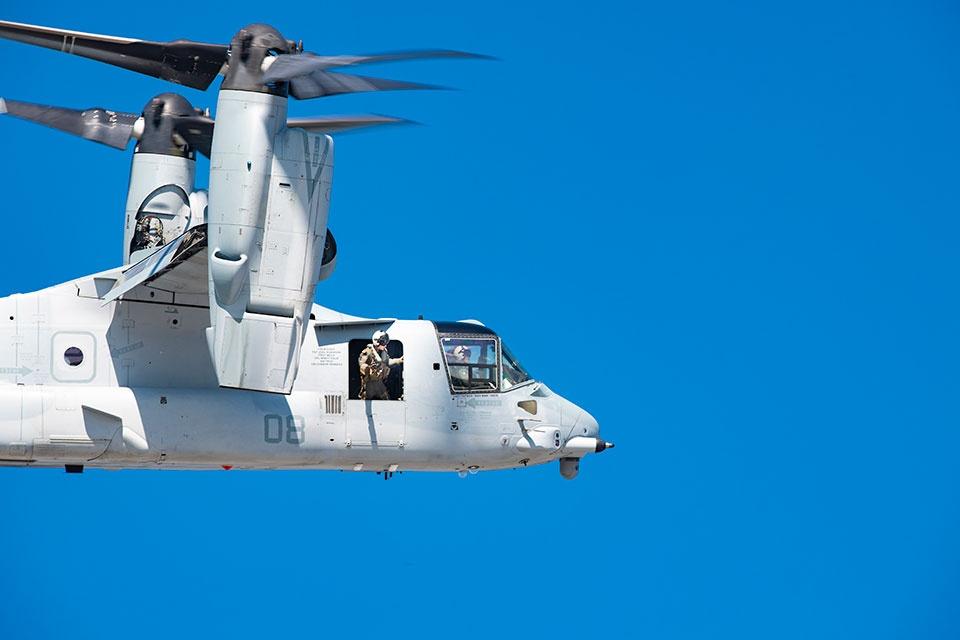The V-22 Osprey is so important to the military that its grounding was lifted on Friday despite the services not knowing why a critical failure occurred.
Naval Air Systems Command’s (NAVAIR) early morning release stated that it has issued a flight clearance for the V-22 Osprey thereby lifting the three-month grounding of the multi-service Osprey fleet.
Brief and lacking in meaningful detail, the press release nonetheless asserted that the decision to return the V-22 to flight status followed a “meticulous and data-driven approach prioritizing the safety of our aircrews.”
Prior to lifting the grounding, NAVAIR, the V-22 Joint Program Office (JPO) and the Air Force delved into the causes behind a “materiel failure” of a V-22 component identified in a preliminary investigation following the loss of an Air Force CV-22B and eight Airmen aboard in a November 29 accident in the waters off Yakushima, Japan. The V-22 fleet was subsequently grounded on December 6.
But none of the above has shared details of exactly what the materiel failure that downed the CV-22B was nor what component(s) it affected.
Other recent Osprey accidents have been linked to an “input quill assembly” which connects the Osprey’s engine to its proprotor gear box. This assembly apparently suffered early fatigue in V-22s, causing a series of clutch malfunctions (“hard clutch engagements”- HCE) in Marine Corps and Air Force MV-22B/CV-22Bs in 2022.
The problem led to the grounding of portions of the Air Force and Marine Corps fleets in 2023. As of last Spring, an effort to replace input quill assemblies in V-22s had made significant progress but the root cause of the HCEs had not been determined. Regardless, the aircraft were returned to flight status again, arguably setting a precedent for lifting the most recent grounding.
A media roundtable held last Wednesday (in which I did not participate) in advance of the return-to-flight announcement featured leadership from the JPO, the Marines, Air Force and Navy. Despite repeated queries from reporters, I’m told that key questions about the origins of the problem that led to the grounding and a solution for it went unanswered by the officials in attendance.
According to Defense News, V-22 joint program manager, USMC
USMC
However, none of the officials at the meeting including Col. Taylor, Brig. Gen. Richard Joyce, (assistant deputy commandant for aviation for the Marines), Vice Adm. Daniel Cheever (Commander of Naval Air Forces) and Lt. Gen. Tony Bauernfeind (Air Force Special Operations Command chief) would say when or if a fix will be introduced for the component failure that led to the recent grounding.
They also offered no response to questions on what specific flight envelope restrictions V-22s in Marine, Air Force and Navy service will have to adhere to as they return to flying routine sorties and eventually to specific mission tasking in deployed situations.
They’re nevertheless expected to resume operational flying as the investigation into the November 29 accident continues. The resumption of flying despite a serious known issue is an indication of the operational hit taken by the services during the grounding, particularly the Marines who operate the bulk (348 MV-22Bs) of the Osprey fleet.
The Marines have had to turn helicopters (their own CH-53Es and UH-1Ys as well as Navy and Army helicopters) and fixed wing aircraft to shuttle people, weapons and supplies to and from ship decks and ground bases.
The workaround has a put a strain on these other platforms and units for three months, the depth of which the Marines have not fully revealed. To a lesser degree the Air Force and Navy have had to sub-in other aircraft (in the Navy’s case notably relying on the retiring C-2A Greyhound carrier onboard delivery aircraft still in its inventory) and units to replace the capabilities lost with grounding of their CV-22Bs/CMV-22Bs.
According to NAVAIR, maintenance and procedural changes (more frequent inspections, new safety protocols) are being implemented to address the materiel failure that allow for a safe return to flight. The Navy, Marine Corps, and Air Force will each execute their return to flight plans according to service specific plans.
The return to flight will take time officials acknowledge. Months of refresher training for rusty aircrews and maintainers will be required before the fleets of each service can return to full flying at full mission capability.
Even with maximized simulator training time for the senior aircrews in each service who will resume flying first, it will be well over a month before something approaching regular flights commence. A return to operational business as usual will probably not be achieved until early summer and the services have not projected a specific time frame for full capability.
Training in the V-22 aircrew pipeline will have to be spun back up as well, with aircraft conversion units unlikely to begin advancing and graduating students for a similar number of months.
Given the lack of information on flight envelope or other operating restrictions for the V-22 fleet, it’s likewise difficult to define what full operational capability will look like.
Defense News reported that one of the most immediate operational requirements contingent upon the return to full readiness is the forthcoming Spring deployment of the USS Boxer ARG with the 15th MEU. Brig. Gen. Joyce reportedly said that it was not certain whether MV-22s will be able to deploy with the 15th MEU when lit leaves California.
The pressure to get them ready will surely be high. As NAVAIR’s release stresses, “The V-22 plays an integral role in supporting our Nation’s defense and returning these vital assets to flight is critical to supporting our nation’s interests.”
The fact that they are being returned to flight with what many observers consider a lack of transparency is underlined by separate investigations into the November crash by the Government Accountability Office and House Committee on Oversight and Accountability. Along with the continuing Air Force investigation, they may provide some answers to the slate of questions surrounding the V-22.
It’s worth noting that the recent accidents (four in two years) and groundings have raised broader questions about the operational safety of tiltrotor (or tilt-wing) aircraft in general including the Army’s forthcoming Future Long Range Assault Aircraft (FLRAA) which will be based on Bell’s V-280.
Lifting the Osprey’s grounding is only a start. The story will continue to unfold as operations recommence and investigations continue. As all of the above hovers in the air, it’s reasonable to assume that V-22 aircrew and their families have additional concerns. Despite NAVAIR’s assertion that it “remains committed to transparency and safety regarding all V-22 operations,” they haven’t been fully answered.
Read the full article here





